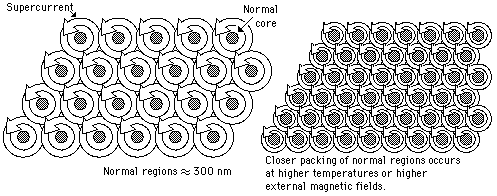

http://www.imagesco.com/catalog/SuperConductor/SuperConductor02.jpg (Meissner Effect)
The physics that govern the superconducting qualities themselves are very involved and complex, and are beyond the scope of this site, however, a basic explanation of their function will be given.
A very interesting property of superconductors is their ability to "push" magnetic flux out of itself. This is done when eddy currents are induced in the superconductor that produce a maganetic field that is equal and opposite to the initial magnetic field.
http://www.physnet.uni-hamburg.de/home/vms/reimer/htc/pt2.html
As shown in the above diagram, when a magnet comes close to a superconducting material, the magnetic flux is "pushed" out and the magnet hovers. This is an amazing phenomena called the Meissner Effect, shown by the picture at the top of this page and this short video clip: Meissner Effect. The next question, is how a state of zero resistance is attained. For type I superconductors, this is best described by the BCS Theory.
When eletrons flow through a material in the form of current, they bump into impurities in the lattice of atoms. These collision cause vibration which in turn produces heat. It is these lattice vibrations which give a material its resistive properties. It would be logical to assume that a better conductor would have fewer lattice vibrations and as it got colder it would become and even better conductor, however, this is not the case with superconductors. The lattice vibrations themseleves are responsible for the free passage of current. As a good room-temperature conductor gets colder, its lattice begins to "freeze" and become very rigid, as a poor room-temperature conductor cools, its lattice also begins to "freeze," but at a slower rate, which give the lattice some room for distortion. In 1957, three American physicists, John Bardeen, Leon Cooper, and John Schrieffer used these facts to create what came to be known as the BCS Theory. In it, they explained that at low temperatures, electrons teamed up into "pairs" and traveled through the lattice without collisions. They explained that as one electron passed through the lattice, the lattice distorted toward the electron, creating a "tunnel" of positively charged particles which then attracted a second electron which passed through the same path as the first. The BCS Theory went on to describe how when the lattice was distorted small pockets of sound were created, called "phonons," and when pairs of electrons (called Cooper Pairs), traveled through the lattice, one was said to emitt a phonon and the other to absorb it.


http://www.physnet.uni-hamburg.de/home/vms/reimer/htc/pt3.html
Type II superconductors work a little different than type I. Instead of completely pushing the magnetic flux out of itself, it rather enters what can be called the vortex state, where there are many cores of regular magnetic material surrounded by superconducting material. As the temperature of the material increases (starting from absolute zero), the normal cores become bigger, and eventually overlap, reverting the substance back to a normal conducting state.

http://hyperphysics.phy-astr.gsu.edu/hbase/solids/scbc.html#c4
Magnetic flux penetrates the conductor, but only in the cores, the superconducting areas still exclude flux. These cores with circulating currents are called "fluxoids." The diagram above shows two superconducting materials. The superconductor on the left has a lower temperature than the one on the right, and subsequently a lower fluxoid density (because of the smaller cores).